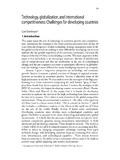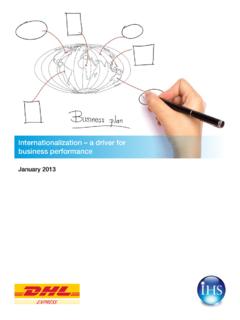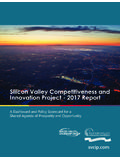Transcription of Global steel 2013 - EY - United States
1 Global steel 2013A new world, a new strategyContents Executive summary234567Is there value in vertical integration?Striving for strategic cost reductionOptimizing capital maximizing returns for shareholders Chinese steel sectorIs India on track to become the next steel powerhouse? Other key producer countries outlook 2013 46101418223036 Maintaining value in volatile economic conditions a look at the year ahead1 Contents Executive summary234567Is there value in vertical integration?Striving for strategic cost reductionOptimizing capital maximizing returns for shareholders Chinese steel sectorIs India on track to become the next steel powerhouse? Other key producer countries outlook 2013 46101418223036 Maintaining value in volatile economic conditions a look at the year ahead1 Global steel will 2013 be the bottom of the trough?
2 Despite a slight increase in demand for steel and the removal of some older steelmaking capacity in 2012, the Global percentage level of excess capacity is greater now than it was 12 months ago due to the continued growth in new steelmaking facilities particularly in developing utilization rates in the sector remain below 80%, and in 2013 excess capacity will remain the most signifi cant issue in the steel in Global steel demand is unlikely to improve signifi cantly in 2013 . Sluggish demand combined with excess steelmaking capacity and ongoing volatility in raw materials costs will challenge the sustainability of high-cost continued closure of older, higher-cost steelmaking capacity and increased demand growth should lead to improved profi tability for the sector in 2014 and 2015, driven by better utilization rates.
3 The closure of ineffi cient capacity will require the sector to avoid political interference with commercially rational sustainable valueErnst & Young s 2012 steel report detailed the importance of customer reach, operational agility, cost competitiveness and stakeholder confi dence for producers to remain profi table. These remain priorities for big challenge for steelmakers in 2013 is how to be cost competitive while maintaining enterprise value. To achieve this, producers need to assess and address whether they are best set up for the new operating environment: Is there value in vertical integration? Strategic cost reduction for survival and future growth The optimal capital structure for the future business modelIs there value in vertical integration?
4 In recent years, many steelmakers have integrated raw material (coal, iron ore) mines into their supply chains. However, new analysis by Ernst & Young suggests that despite the benefi ts in controlling raw material costs, it may not always have a positive benefi t on enterprise should critically assess the value of vertical integration to their business and consider alternatives to managing raw material costs and supply, such as long-term contracts with suppliers and relocating production sites closer to upstream cost reductionWith continuing weak market conditions, cost reduction activities are essential for steelmakers sustainability and future growth. While these activities are necessary, it is crucial that steelmakers do not move away from their overall company strategy, thus potentially causing further value erosion.
5 In this report we discuss the different approaches that are currently being used to reduce cash operating costs, including: Reducing production volumes from loss making plants to stabilize steel prices and address oversupply in the market Controlling raw material costs is a benefi t of vertical integration; however, steelmakers should critically assess the value of vertical integration and consider possible alternatives to help mitigate the cost of raw materials. Mike ElliottGlobal Mining & Metals Leader, Ernst & Young Executive Global steel 20134 Restructuring labor Canceling or reducing supply contracts Optimizing capitalToday s economic environment is forcing steelmakers to assess whether their capital structure is optimized for the new operating environment.
6 Companies must objectively review the alignment of their asset portfolios to their business strategies. The goal for companies is the optimal allocation of capital to maximize shareholder returns and achieve the most effi cient capital structure. As a result, an increasing number of corporate boards are putting greater focus on the key drivers of effi cient capital allocation. This focus is extremely relevant to steelmakers because falling demand and oversupply in regional markets have led to short-term liquidity challenges that may threaten credit ratings and debt covenants. Capital management today includes: Building in options Capital raising Divesting non-core assetsChina restructuringChina remains the largest market in the steel sector, even though it experienced lower steel demand, overcapacity, a fragmented industry and weak profi t margins in 2012.
7 The Chinese government aims to address these challenges through its 12th Five-Year Plan (FYP), which represents China s goal to rebalance its economy and shift the focus from investment toward consumption and move development from urban areas to rural In terms of the steel sector, the 12th FYP focuses on promoting the use of modern technology, energy effi ciency and improved product quality. Successful execution of the 12th FYP policies will not only help contribute to the domestic and Global steel demand, but also promote the production of value-added steel . Is India on track to becoming the next steel powerhouse?Although China is the dominant market in the steel sector, India is increasing its presence in the Global steel market as a result of domestic steel consumption.
8 The rising middle class population coupled with increased urbanization will grow steel intensity in the economy. India has seen a rapid rise in production over the past few years, which has resulted in India becoming the fourth largest producer of crude steel and the largest producer of sponge iron in the world. There are many opportunities that are helping grow the Indian steel market. These opportunities include: Rural demand picking up Investment planned in road sector Indian railway expansion Automobile and power sectors offer opportunity for specialized steel Refocus on manufacturingHowever, there are also some challenges that India must overcome in order to continue on the path of becoming the next steel powerhouse.
9 These challenges include: Land acquisition and environment regulations Shortage of coking coal Availability and pricing of domestic iron ore Downstream value addition Insuffi cient infrastructure and logistics Overburdened port facilities Adoption of modern technologysummary1 China s rebalancing push needs tailor-made policy, Shanghai Daily, 20 December 2012, Factiva, steel 2013 Global steel 20136 Maintaining value in volatile economic conditions a look at the year aheadIn addition to the adaptation factors raised in Ernst & Young s Global steel 2012: competing for growth in the steel sector, steel producers must also be considering for 2013 : The continued appropriateness of the vertically integrated model The embracing of more fl exible cost structures and overall reductions Optimizing capital structures and allocationsAs the largest and most dominant market in the steel sector, China continues to surprise, both in its size and dynamism.
10 But as China heads toward its peak, India is picking up the pace and increasing its presence in the Global sector. This silent achiever is becoming the market to takes its place in the Global economy The world economy is expected to have grown by in 2012 and grow in This growth is primarily driven by the BRIC nations, with most of this growth coming from China and India. They expect to have grown, respectively, at and in 2012 and will grow and in But these consolidated growth numbers are less than revealing of the underlying uncertainty in the Global economy, especially in Europe and the US. The US economy is expected to grow by around 2% in 2012 and in The European Union (EU) is expected to decline in 2012 and in are challenged by weak Global growth; need for structural change, limited availability of fi nance and high raw material prices.
















